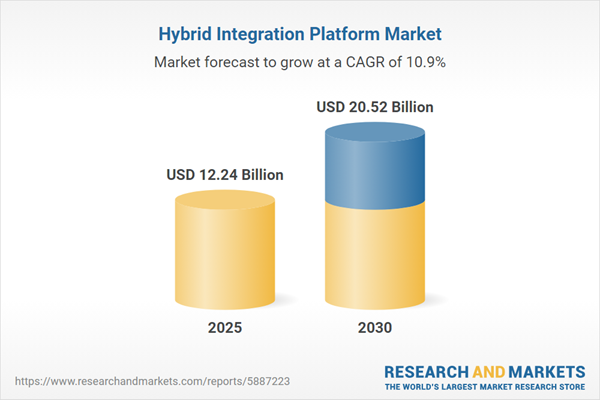Speak directly to the analyst to clarify any post sales queries you may have.
Hybrid integration platforms are becoming pivotal for enterprises seeking unified, secure, and future-ready IT environments. As senior decision-makers navigate digital transformation, these platforms provide the flexibility and compliance needed to modernize operations while integrating legacy infrastructure and cloud solutions.
Hybrid integration platforms equip organizations with the tools needed to unify legacy systems and cloud-based environments, facilitating efficient, secure, and compliant enterprise IT modernization. These versatile platforms are pivotal as businesses accelerate digital transformation, providing a stable, adaptable integration foundation.
Market Snapshot: Hybrid Integration Platform Market
The global hybrid integration platform market continues to demonstrate strong growth. In 2024, it reached USD 11.02 billion and is projected to expand to USD 12.24 billion by 2025, signifying an 11.19% compound annual growth rate. This robust expansion reflects enterprise priorities to seamlessly connect on-premises infrastructures with modern cloud and hybrid architectures. Adoption is diverse, spanning financial services, healthcare, manufacturing, public sector, and retail. Hybrid integration solutions are fundamental for driving operational efficiency, supporting innovation, and meeting stringent compliance needs. Leading solution providers are responding with advanced security features, modular deployment options, and scalable models tailored to support a range of integration strategies across regulated industries.
Scope & Segmentation: Hybrid Integration Platform Market
- Deployment Model: Enterprises can choose from public, private, hybrid, and on-premises deployments, with both subscription and traditional licensing models available to support diverse procurement strategies.
- Integration Type: Solutions cover API management for seamless engagement, cross-system analytics for insights, B2B integration tools such as EDI and RosettaNet, ETL/ELT workflow management, and service bus architectures for secure data transfer.
- Organization Size: Large organizations benefit from extensive customization and robust frameworks for complex environments, while small and midsize enterprises leverage nimble offerings designed for compliance and operational efficiency within budget constraints.
- Industry Vertical: Platforms are designed to address governance, data management, and risk requirements specific to banking, financial services, government, healthcare, life sciences, telecommunications, manufacturing, IT, and retail sectors, each with proprietary integration needs.
- Regional Coverage: North America, South America, Europe, Asia-Pacific, the Middle East, and Africa present varying levels of technology maturity, regulatory compliance, and infrastructure readiness, influencing platform preferences and integration strategies.
- Key Solution Providers: The vendor landscape includes Dell Boomi, Microsoft, MuleSoft, IBM, SAP SE, Oracle, Software AG, TIBCO, SnapLogic, and Jitterbit, offering low-code and no-code solutions as well as fully managed integration services for enhanced customization and support.
Key Takeaways: Strategic Insights and Market Drivers
- Hybrid integration platforms deliver full connectivity across legacy and cloud environments, supporting seamless modernization and adaptive operations for complex businesses.
- With the integration of IoT and cloud-native features, these platforms reinforce security and promote resilient, distributed IT infrastructures aligned with enterprise objectives.
- Industry-specific adoption is driven by unique priorities; for example, financial and healthcare sectors emphasize compliance and risk mitigation, while manufacturing and technology sectors focus on integration speed and interoperability enhancements.
- Large enterprises seek out feature-rich integration environments, while small to midsize businesses prioritize rapid deployment and operational flexibility to accommodate shifting business needs.
- Emerging advances in low-code and AI-powered integration facilitate closer collaboration between business and IT teams, expanding access to managed services and driving greater value from integration investments.
Tariff Impact on Hybrid Integration Platform Strategies
Recent adjustments in US software and hardware tariffs are pushing organizations to localize integration operations and consider modular licensing approaches. This strategy enhances cost effectiveness and operational flexibility, enabling companies to maintain resilience and strategic consistency as global trade dynamics fluctuate. Flexible hybrid integration platform strategies ensure continued alignment with evolving market and regulatory conditions.
Methodology & Data Sources
This analysis incorporates direct perspectives from senior executives, survey responses from IT decision-makers, and a thorough review of secondary research. Feedback from major hybrid integration platform vendors provides further context on regional adoption trends and provider strengths across multiple industries.
Why This Report Matters
- Guides executive decisions with in-depth insights on scalability, compliance, and available enterprise integration platform options.
- Empowers senior technology leaders to optimize governance, manage risk, and support modernization across evolving regulatory landscapes.
- Supports technology selection by detailing vendor capabilities, deployment strategies, and how regulatory changes can impact platform choices.
Conclusion
Hybrid integration platforms are a core enabler for enterprises committed to IT modernization and digital transformation. This report equips decision-makers to refine integration strategies, build operational resilience, and position organizations for long-term success.
Additional Product Information:
- Purchase of this report includes 1 year online access with quarterly updates.
- This report can be updated on request. Please contact our Customer Experience team using the Ask a Question widget on our website.
Table of Contents
3. Executive Summary
4. Market Overview
7. Cumulative Impact of Artificial Intelligence 2025
Companies Mentioned
The companies profiled in this Hybrid Integration Platform market report include:- Dell Boomi, Inc.
- Microsoft Corporation
- MuleSoft, Inc.
- International Business Machines Corporation
- SAP SE
- Oracle Corporation
- Software AG
- TIBCO Software Inc.
- SnapLogic, Inc.
- Jitterbit, Inc.
Table Information
| Report Attribute | Details |
|---|---|
| No. of Pages | 183 |
| Published | November 2025 |
| Forecast Period | 2025 - 2032 |
| Estimated Market Value ( USD | $ 12.24 Billion |
| Forecasted Market Value ( USD | $ 25.75 Billion |
| Compound Annual Growth Rate | 11.1% |
| Regions Covered | Global |
| No. of Companies Mentioned | 11 |









